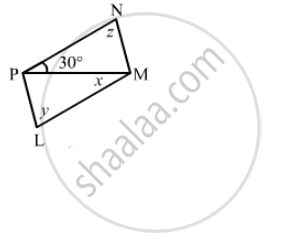Advertisements
Advertisements
प्रश्न
Two adjacent angles of a parallelogram are as 1 : 2. Find the measures of all the angles of the parallelogram.
उत्तर
\[\text{ Let the angle be A and B }. \]
\[\text{ The angles are in the ratio of 1: 2 } . \]
\[\text{ Measures of } \angle A \text{ and } \angle B \text{ are } x° \text{ and } 2x° . \]
\[Then, \angle C = \angle A and \angle D = \angle B (\text{ opposite angles of a parallelogram are congruent })\]
\[\text{ As we know that the sum of adjacent angles of a parallelogram is } 180°. \]
\[ \therefore \angle A + \angle B = 180°\]
\[ \Rightarrow x° + 2x°= 180°\]
\[ \Rightarrow 3x° = 180°\]
\[ \Rightarrow x°= \frac{180°}{3} = 60°\]
\[\text{ Thus, measure of } \angle A = 60°, \angle B = 120°, \angle C = 60° \text{ and } \angle D = 120° .\]
APPEARS IN
संबंधित प्रश्न
All rhombuses are parallelograms.
The following figure is parallelogram. Find the degree values of the unknown x, y, z.

Which of the following statement is true for a rhombus?
It is a quadrilateral.
The diagonals of a quadrilateral are perpendicular to each other. Is such a quadrilateral always a rhombus? If your answer is 'No', draw a figure to justify your answer.
ABCD is a rhombus. If ∠ACB = 40°, find ∠ADB.
ABCD is a rhombus and its diagonals intersect at O.
(i) Is ∆BOC ≅ ∆DOC? State the congruence condition used?
(ii) Also state, if ∠BCO = ∠DCO.
Lengths of diagonals of a rhombus ABCD are 16 cm and 12 cm. Find the side and perimeter of the rhombus.
In a rhombus diagonals intersect at ______ angles.
Diagonals of a quadrilateral are perpendicular to each other. Is such a quadrilateral always a rhombus? Give a figure to justify your answer.
Construct a rhombus whose side is 5 cm and one angle is of 60°.
